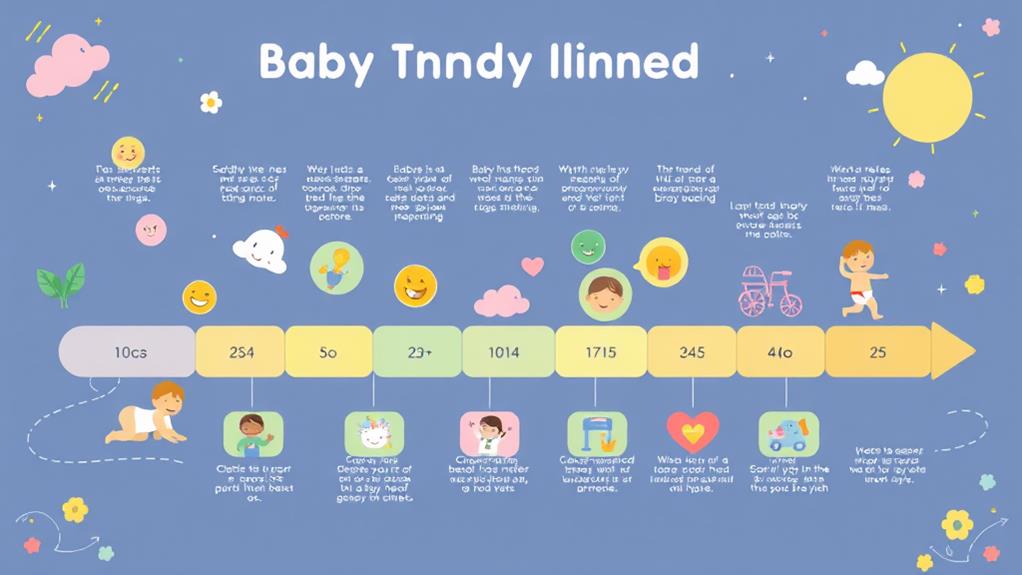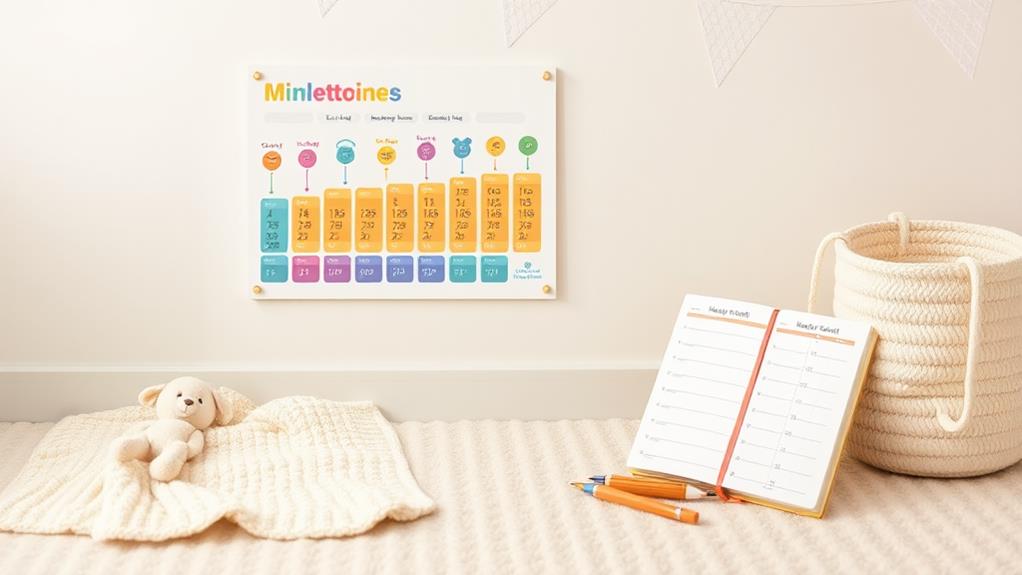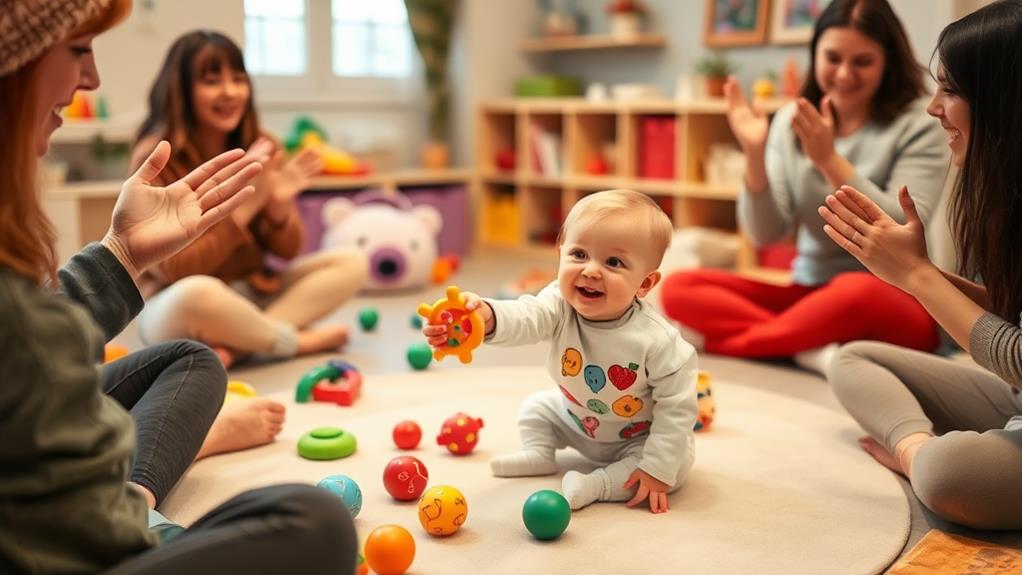Tracking your baby's physical milestones is crucial for understanding their development and ensuring they're on the right path. By using helpful tips and charts, you can easily monitor key achievements like rolling over or taking that first step. It's not just about keeping records; these tools can enhance your communication with healthcare professionals and help you celebrate those significant moments. But what are the specific milestones you should focus on, and how can you effectively utilize these charts? Let's explore some essential insights that will guide you through this journey.
Understanding Physical Milestones
As a parent, it's essential to understand the physical milestones your baby will reach during their first year. These milestones are key markers of development and can help you gauge your little one's growth.
Your baby will typically start by lifting their head during tummy time around 2 months old. By 4 to 6 months, they'll likely be able to roll over, which can be exciting to witness!
As they approach 6 to 9 months, you might see them sitting up independently. Crawling usually begins around 8 to 10 months, and this newfound mobility can turn your home into an adventure zone.
By their first birthday, many babies can pull up to stand and may even take their first steps!
It's important to remember that each baby develops at their own pace. Some may skip crawling altogether and go straight to walking, while others may take a little longer to reach certain milestones.
Keep encouraging your baby with plenty of tummy time and safe spaces to explore. Celebrate their achievements, no matter how big or small, and enjoy this exciting journey of growth and discovery together!
Importance of Tracking Growth
Tracking your baby's growth is crucial for understanding their development and addressing any potential concerns early on. By keeping an eye on their growth patterns, you can gain insights into their overall health and well-being. Regularly measuring your baby's height, weight, and head circumference helps you identify whether they're on track with their growth milestones.
When you track growth, you also create a valuable record that can be shared with your pediatrician. This information allows healthcare professionals to spot any underlying issues. If your baby isn't growing as expected, early intervention can make a significant difference.
Additionally, watching your baby's growth can be a rewarding experience. You'll celebrate each new achievement as they reach different milestones, building a deeper bond with your little one.
You'll feel more confident in your parenting skills as you notice patterns and trends in their development.
Key Milestones by Age

From the moment your baby arrives, you'll notice a series of incredible milestones that mark their physical development. These key milestones generally occur within specific age ranges, helping you track your child's growth.
In the first few months, your baby will start to lift their head while lying on their tummy. By around 4 to 6 months, they'll likely roll over and sit up with support. As they approach 9 months, you might see them crawling or scooting around, exploring their environment.
When your little one hits the 12-month mark, they may take their first unsteady steps, a thrilling moment for any parent. By 18 months, they often walk independently and might even start to climb.
As they reach 2 years old, you can expect more advanced skills, like running, kicking a ball, or even climbing stairs with help.
At 3 years, your child may be able to hop, throw a ball overhand, or jump in place. Each milestone is a building block in their physical development, so celebrate these achievements as they happen.
Tools for Monitoring Progress
To keep up with your baby's physical milestones, utilizing various tools can make the process easier and more engaging. You might consider a baby milestone tracker app. These apps often come with reminders and can help you log your baby's progress consistently. They may also offer tips tailored to your child's age, so you can stay informed about what to expect next.
Another useful tool is a physical milestone chart. You can print these out and hang them on your wall or keep them in a baby book. They provide a visual guide, allowing you to mark each milestone as your baby achieves it. Watching those checkmarks add up can be incredibly motivating!
Don't forget about using a journal. Writing down observations about your baby's activities and achievements allows you to reflect on their growth over time. Plus, it can be a wonderful keepsake for you and your child.
Lastly, consider sharing progress with family and friends through social media. This not only keeps loved ones in the loop but can also provide you with encouragement and support as you celebrate each milestone together.
Using Milestone Charts Effectively

A milestone chart can be an invaluable resource for parents eager to track their baby's development. It helps you visualize your child's growth and understand what to expect at different stages. When you use these charts, start by familiarizing yourself with the specific milestones for your baby's age. Each milestone covers areas like motor skills, language, and social interactions, so you can monitor overall progress.
To use the chart effectively, mark each milestone as your baby achieves it. This not only gives you a sense of accomplishment but also allows you to see patterns in your child's development. If you notice your baby is reaching milestones consistently, that's a great sign!
However, remember that every child develops at their own pace. Don't stress if your baby takes a little longer to reach certain milestones; instead, use the chart as a guideline.
It's also helpful to share the chart with your pediatrician during check-ups, as they can provide additional insights. By actively engaging with milestone charts, you'll feel more connected to your child's growth journey and more informed about their development. Enjoy the process!
Signs of Developmental Delays
Often, parents may worry about their child's development and wonder if they're reaching milestones on time. It's natural to feel anxious, but knowing the signs of developmental delays can help you understand when to seek guidance.
If your baby isn't rolling over by six months or isn't sitting up by nine months, these could be early indicators. Additionally, if they don't show interest in toys or struggle to grasp objects by the age of one, it's worth noting.
By 12 months, babies typically should be able to say a few words and respond to simple requests. If you notice your child isn't doing these things, it might be a sign of delay.
Watch for social cues too. If your little one doesn't smile back at you or seems disengaged with others, it could be concerning. Delays can manifest differently, so trust your instincts.
Every child develops at their own pace, but keeping an eye on these signs can empower you to take action if needed. Don't hesitate to talk to your pediatrician if you have concerns; early intervention can make a significant difference in your child's development.
Tips for Encouraging Movement

Recognizing signs of developmental delays can help you identify when your child might need extra support. To encourage movement, start by creating a safe environment for exploration. Clear away sharp objects and ensure the play area is soft and spacious, giving your little one room to move freely.
You can also use engaging toys to spark their interest. Colorful balls, soft blocks, or toys that make sounds can motivate them to reach, crawl, or even roll.
Additionally, getting down on the floor with them can make a big difference. Show them how to play with the toys and model movements such as crawling or rolling over.
Another great tip is to set up obstacle courses using pillows or blankets. This not only makes moving fun but also encourages problem-solving as they navigate through the course.
Don't forget to praise their efforts, as positive reinforcement can boost their confidence and motivate them to try new movements.
Lastly, incorporate music and dancing into playtime. Babies love rhythm, and moving to music can stimulate their desire to sway, bounce, or even dance, which promotes physical development.
Keeping it fun and interactive will help encourage your child's movement naturally!
Consulting Healthcare Professionals
Consulting healthcare professionals can be crucial in monitoring your baby's physical milestones. Regular check-ups allow pediatricians to assess your baby's development and offer personalized advice. They can help you understand what to expect as your little one grows, ensuring you're aware of any potential concerns.
Don't hesitate to bring up any questions or worries you have during these visits. Whether you're curious about your baby's crawling or walking, your healthcare provider can offer valuable insights. They often use growth charts to track progress and identify trends, helping you see how your child compares to developmental norms.
If you notice delays or unusual patterns in your baby's movements, it's important to share these observations. Early intervention can make a significant difference in your child's development, so trust your instincts. Your pediatrician may recommend specialists if needed, providing a team approach to support your baby's growth.
In addition, they can guide you on activities that promote physical development, ensuring you're nurturing your child's progress.
Celebrating Milestone Achievements

As your baby hits each physical milestone, it's important to take a moment to celebrate these achievements together. Milestones like rolling over, sitting up, or taking those first wobbly steps can be incredibly exciting for both you and your little one. Recognizing these moments not only boosts your baby's confidence but also strengthens your bond.
Celebrate in ways that feel meaningful to you. You could throw a small family gathering, share the news with friends, or create a scrapbook page to document the milestone. Simple things like a special meal or a fun outing can make the occasion feel significant.
Consider taking a photo or video to capture the moment, creating a keepsake to look back on together.
Don't forget to verbalize your excitement! Cheer for your baby and let them know how proud you are. Your enthusiasm will encourage them to continue exploring and learning.
